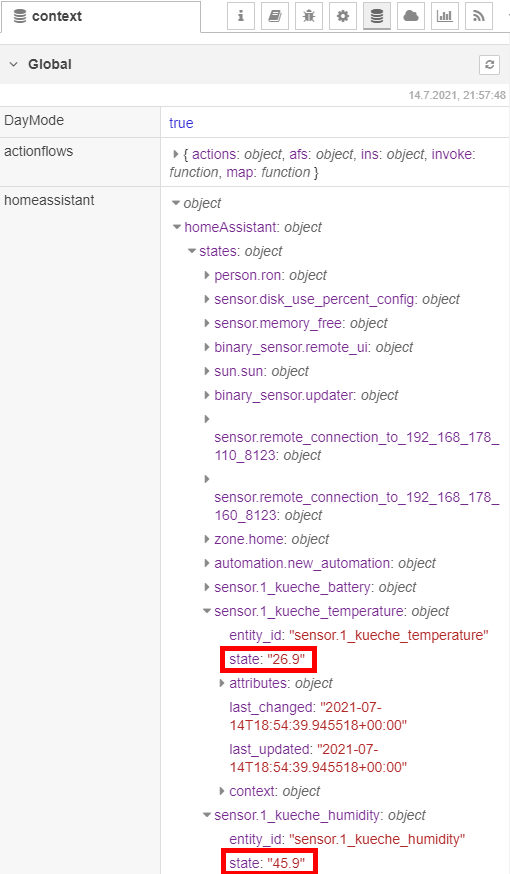While I understand your point that you want to access all values directly inside a function node I think you didn’t get what we said about the current_state node.
Your picture shows state-change nodes not current_state ones. You would only need one current_state node like this:
[{"id":"3b6d2e6.bcde2d2","type":"api-current-state","z":"cc639dbb.119d5","name":"","server":"44b2605f.5d41","version":2,"outputs":1,"halt_if":"","halt_if_type":"str","halt_if_compare":"is","entity_id":"sensor.{{room}}.temperature","state_type":"num","blockInputOverrides":false,"outputProperties":[{"property":"payload","propertyType":"msg","value":"","valueType":"entityState"},{"property":"data","propertyType":"msg","value":"","valueType":"entity"}],"override_topic":false,"state_location":"payload","override_payload":"msg","entity_location":"data","override_data":"msg","x":680,"y":120,"wires":[["88f77c12.4515e"]]},{"id":"f4bdc1ec.bb3e8","type":"inject","z":"cc639dbb.119d5","name":"","props":[{"p":"room","v":"wohnzimmer","vt":"str"}],"repeat":"","crontab":"","once":false,"onceDelay":0.1,"topic":"","payloadType":"str","x":390,"y":80,"wires":[["3b6d2e6.bcde2d2"]]},{"id":"839dd426.946fb8","type":"inject","z":"cc639dbb.119d5","name":"","props":[{"p":"room","v":"küche","vt":"str"}],"repeat":"","crontab":"","once":false,"onceDelay":0.1,"topic":"","payloadType":"str","x":390,"y":140,"wires":[["3b6d2e6.bcde2d2"]]},{"id":"88f77c12.4515e","type":"debug","z":"cc639dbb.119d5","name":"","active":true,"tosidebar":true,"console":false,"tostatus":false,"complete":"true","targetType":"full","statusVal":"","statusType":"auto","x":1000,"y":120,"wires":[]},{"id":"44b2605f.5d41","type":"server","name":"Home Assistant","version":1,"legacy":false,"addon":true,"rejectUnauthorizedCerts":true,"ha_boolean":"on","connectionDelay":false,"cacheJson":false}]
Imagine each inject node as a call from your echo with different rooms requested.
 . Anybody here had the same problem and found a smooth workaround for it (obviously beside implementing a bunch of “event: state” nodes updating self created global variables).
. Anybody here had the same problem and found a smooth workaround for it (obviously beside implementing a bunch of “event: state” nodes updating self created global variables).



 Honestly I didn´t make use of Websockets so far and couldn´t even find the palette you are referring to. Maybe I missed a great opportunity, so I´m eager to learn more about how obviously “most users” tackle those kind of issues
Honestly I didn´t make use of Websockets so far and couldn´t even find the palette you are referring to. Maybe I missed a great opportunity, so I´m eager to learn more about how obviously “most users” tackle those kind of issues  But frankly speaking I still don´t see much of an advantage over just using a function node together with the delivered information through global variables…
But frankly speaking I still don´t see much of an advantage over just using a function node together with the delivered information through global variables… (Just kidding).
(Just kidding).